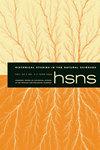倾听的艺术
IF 0.3
3区 哲学
Q2 HISTORY & PHILOSOPHY OF SCIENCE
引用次数: 0
摘要
音乐和地震学融合在加州理工学院教授雨果·贝尼奥夫的日常工作中,他将20世纪20年代的前卫技术与19世纪赫尔姆霍尔茨对音乐的美学、文化和科学理解结合在一起。换能器促进了这种融合,在科学和音乐之间进行调解,并允许以新的方式收听可听范围之外的波。贝尼奥夫有倾听的能力——这里的“倾听”不是被动的感知,而是一种主动的搜索,以区分和分离信号和噪音,无论是来自乐器内部还是外部。四十多年来,贝尼奥夫一直是一位声音专家,致力于各种类型和频率的波浪和振动的记录和再现。在追溯贝尼奥夫传记的元素之后,我研究了他是如何将他工作室里的换能器技术融入到他的地震学和乐器中去的,这些仪器不仅以其现代主义设计的控制、简洁和清晰的线条而闻名,而且还以一种新的诗意技术而闻名。贝尼诺夫的地震仪器使人们有可能听到各种各样以前无法探测到的现象,比如地球的自由振荡,他与钢琴家罗莎琳·图莱克(Rosalyn Tureck)在电子乐器上的合作旨在重现传统乐器的纯净声音。我认为,贝尼奥夫对现代科学与迷人世界观的美学调和的探索,在很大程度上是两次世界大战之间的社会、文化、技术和科学条件的产物。本文章由计算机程序翻译,如有差异,请以英文原文为准。
The Art of Listening
Music and seismology merged in the daily work of the Caltech professor Hugo Benioff, who united the avant-garde technology of the 1920s with a nineteenth-century Helmholtzian aesthetic, cultural, and scientific understanding of music. The transducer facilitated this merger, mediating between science and music and allowing for new ways of listening to waves outside the audible range. Benioff had the capacity to listen—“listening” understood here not as passive perception, but as an active search to distinguish and separate signal from noise, whether from in- or outside of the instrument. For more than forty years, Benioff worked as a sonic expert, perfecting the recording and reproduction of waves and vibrations of all types and frequencies. After tracing elements of Benioff’s biography, I examine how he incorporated the technology of the transducer in his workshop into his seismological and musical instruments, notable not only for the control, austerity, and clarity of lines of their modernist design, but also for a new kind of poetic technology. Benioff’s seismological instruments made it possible to listen to a large variety of previously undetectable phenomena such as the free oscillations of the earth, and his work with the pianist Rosalyn Tureck on electric musical instruments aimed to reproduce the pure sound of traditional instruments. I argue that Benioff’s search for an aesthetic reconciliation of the scientific modern with an enchanted view of the world is very much a product of the social, cultural, technical, and scientific conditions of the interwar period.
求助全文
通过发布文献求助,成功后即可免费获取论文全文。
去求助
来源期刊

Historical Studies in the Natural Sciences
社会科学-科学史与科学哲学
CiteScore
1.00
自引率
0.00%
发文量
24
审稿时长
>12 weeks
期刊介绍:
Explore the fascinating world of Historical Studies in the Natural Sciences, a journal that reveals the history of science as it has developed since the 18th century. HSNS offers in-depth articles on a wide range of scientific fields, their social and cultural histories and supporting institutions, including astronomy, geology, physics, genetics, natural history, chemistry, meteorology, and molecular biology. Widely regarded as a leading journal in the historiography of science and technology, HSNS increased its publication to five times per year in 2012 to expand its roster of pioneering articles and notable reviews by the most influential writers in the field.
 求助内容:
求助内容: 应助结果提醒方式:
应助结果提醒方式:


